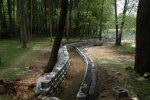85Hokie
Moderator
Staff member
Lifetime Member
Equipment
BX-25D ,PTB. Under Armor, '90&'92-B7100HST's, '06 BX1850 FEL
Guys - Girls,
I got a problem that I need someone with experience on this to lend me a hand.
Back in 2001 I bought some property on a large lake here in VA, gorgeous place, then it was a shoreline.
AT THE TIME the water had receded almost 5 feet!! WHICH was very rare! While this was going on, I constructed a fantastic wall that no owner has on the lake (hard to do when water is there!) - it took me months to do and was a hellva lot of work!
As you see in the pictures, the water when up to full pond comes up about 2/3 of the wall - last picture. 15 years later I have a serious problem!
The same effect that pulls gas through a carburetor is undercutting my wall!!!! AND doing a damn fine job of it!!!!
The water has receded again, about 3 feet - and I can walk in front of the wall, the gravel that was packed with a tamper in 2001 has been undercut by the boats that come around at the end of the cove where I am located, and the wakes come through and run across the face of the wall creating the venturi effect.
I can stick my flat hand under the wall at this time!!!
I am not fear that the wall will collapse - if you look in the pictures you can see the tie back system I used - and there is are 2 pieces of #4 bar hammered down through each of the entire block stacked. SO I feel ok that it will not tumble - but if this keeps up, something bad is gonna happen!
I have raked rock BACK in front - and this might help a bit, but these rock will wash back out........
I can place rip-rap in front, this will help and they will not move, however, it will look like......
I am thinking of actually digging out about a 3" wide trench in front of the wall and using a loose mix of mortar, flowing the mortar BACK under the wall......I have a feeling all that work (100 ft of wall) will not work either!!
I have built a jetty on the incoming side....it seems to help a bit, but the waves stillllll come in and undercut the wall.
Anybody have any thoughts???
thanks in advance
I got a problem that I need someone with experience on this to lend me a hand.
Back in 2001 I bought some property on a large lake here in VA, gorgeous place, then it was a shoreline.
AT THE TIME the water had receded almost 5 feet!! WHICH was very rare! While this was going on, I constructed a fantastic wall that no owner has on the lake (hard to do when water is there!) - it took me months to do and was a hellva lot of work!
As you see in the pictures, the water when up to full pond comes up about 2/3 of the wall - last picture. 15 years later I have a serious problem!
The same effect that pulls gas through a carburetor is undercutting my wall!!!! AND doing a damn fine job of it!!!!
The water has receded again, about 3 feet - and I can walk in front of the wall, the gravel that was packed with a tamper in 2001 has been undercut by the boats that come around at the end of the cove where I am located, and the wakes come through and run across the face of the wall creating the venturi effect.
I can stick my flat hand under the wall at this time!!!
I am not fear that the wall will collapse - if you look in the pictures you can see the tie back system I used - and there is are 2 pieces of #4 bar hammered down through each of the entire block stacked. SO I feel ok that it will not tumble - but if this keeps up, something bad is gonna happen!
I have raked rock BACK in front - and this might help a bit, but these rock will wash back out........
I can place rip-rap in front, this will help and they will not move, however, it will look like......
I am thinking of actually digging out about a 3" wide trench in front of the wall and using a loose mix of mortar, flowing the mortar BACK under the wall......I have a feeling all that work (100 ft of wall) will not work either!!
I have built a jetty on the incoming side....it seems to help a bit, but the waves stillllll come in and undercut the wall.
Anybody have any thoughts???
thanks in advance
Attachments
-
84.8 KB Views: 376
-
98.5 KB Views: 380
-
102.7 KB Views: 404
-
94.3 KB Views: 367









